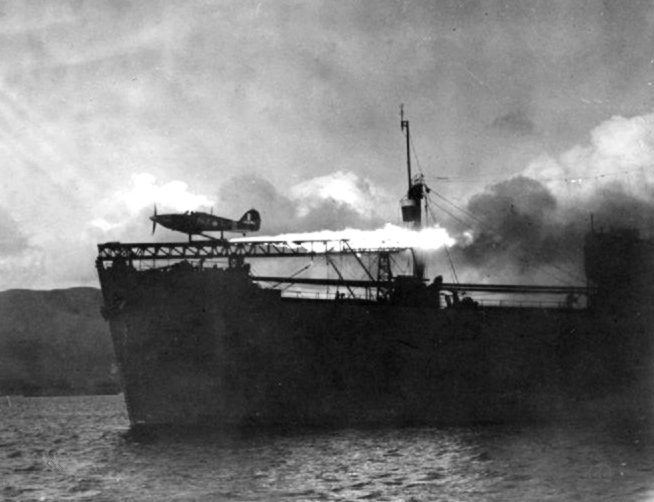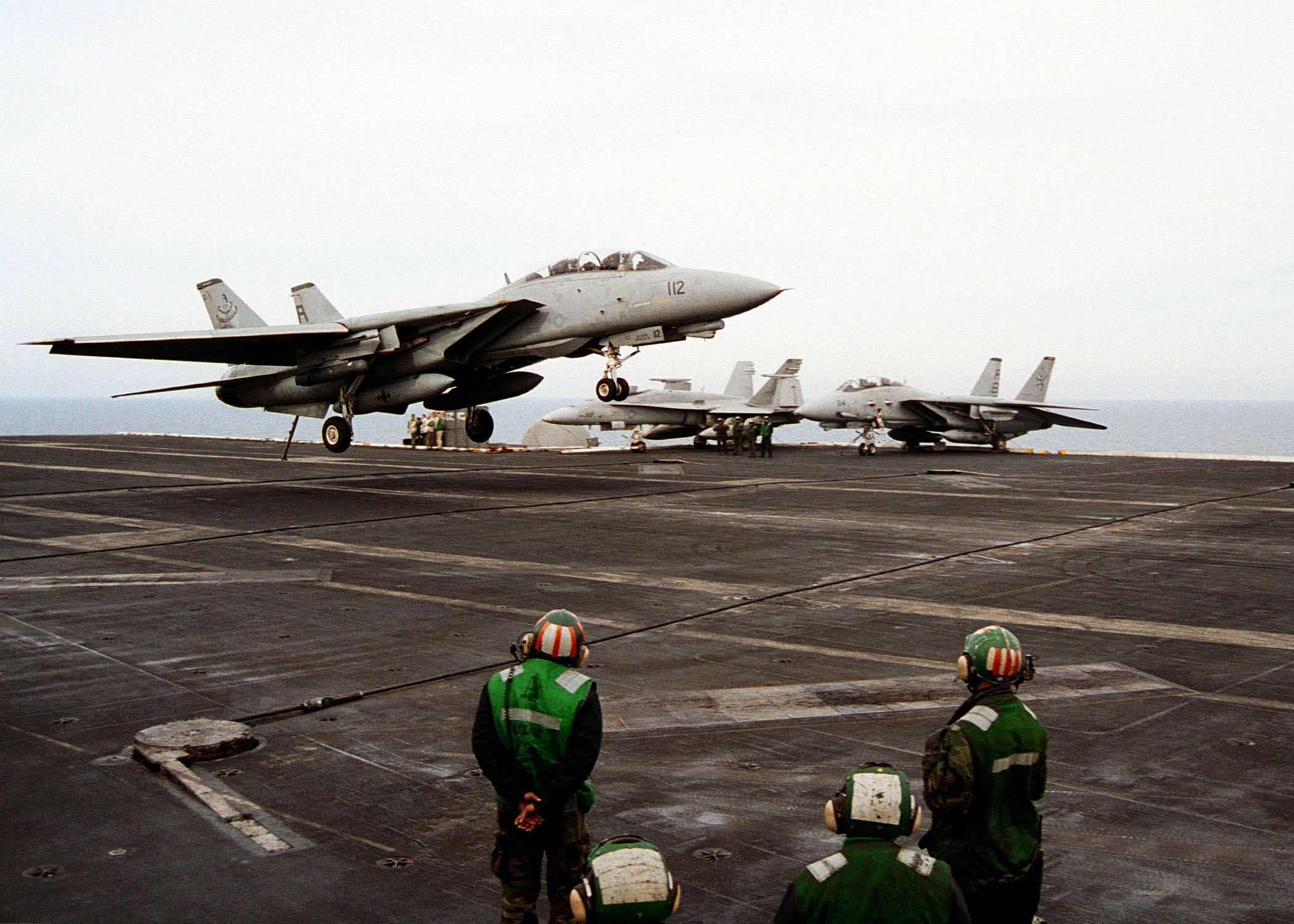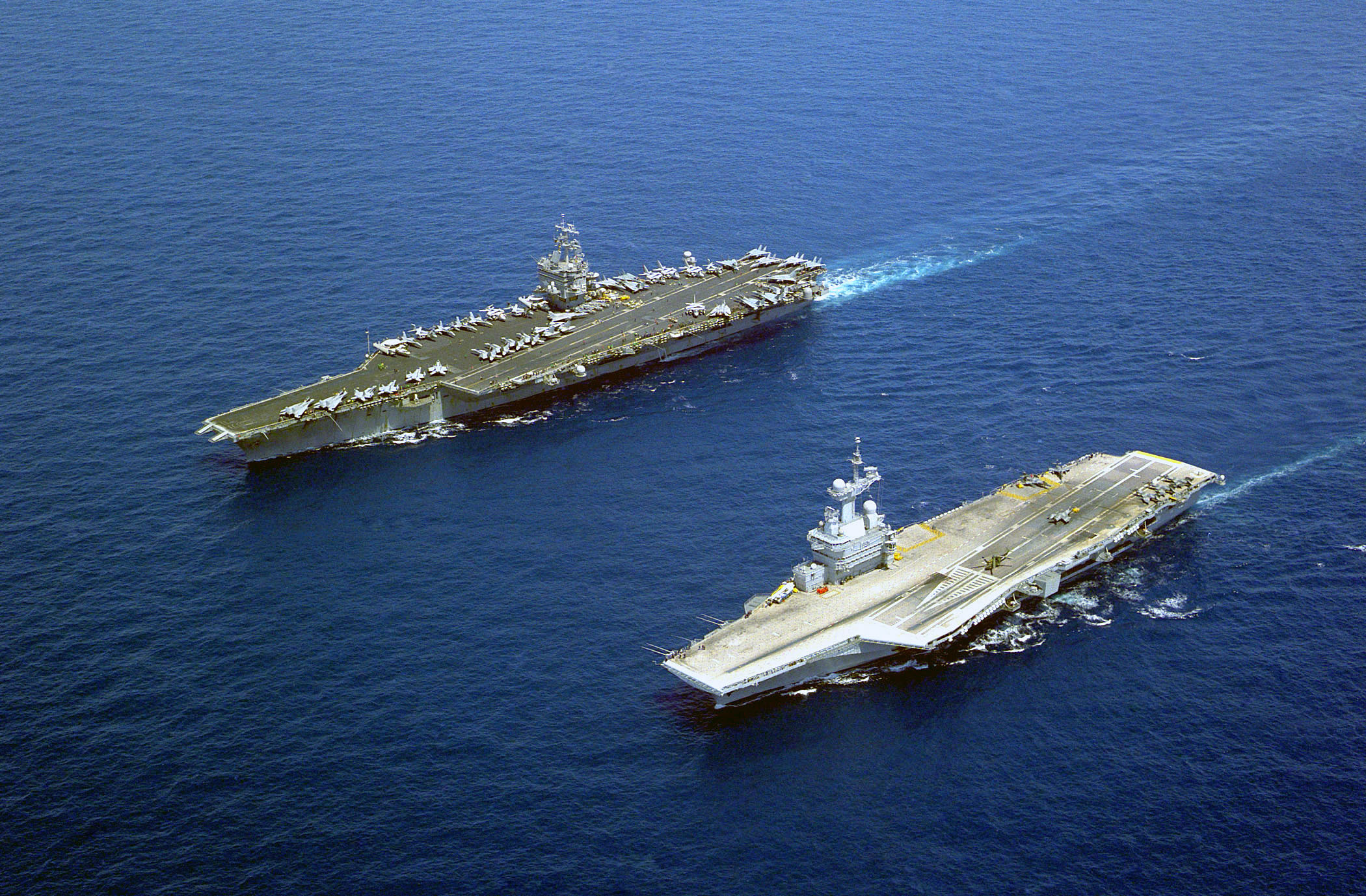|
CATOBAR
CATOBAR (catapult-assisted take-off but arrested recovery or catapult-assisted take-off barrier arrested recovery) is a system used for the launch and recovery of aircraft from the deck of an aircraft carrier. Under this technique, aircraft launch using a catapult- assisted take-off and land on the ship (the recovery phase) using arrestor wires. Although this system is costlier than alternative methods, it provides greater flexibility in carrier operations, since it imposes less onerous design elements on fixed wing aircraft than alternative methods of launch and recovery such as STOVL or STOBAR, allowing for a greater payload for more ordnance and/or fuel. CATOBAR can launch aircraft that lack a high thrust to weight ratio, including heavier non-fighter aircraft such as the E-2 Hawkeye and Grumman C-2 Greyhound. Types The catapult system in use in most modern CATOBAR carriers is the steam catapult. Its primary advantage is the amount of power and control it can provide. Duri ... [...More Info...] [...Related Items...] OR: [Wikipedia] [Google] [Baidu] |
Aircraft Carrier
An aircraft carrier is a warship that serves as a seagoing airbase, equipped with a full-length flight deck and hangar facilities for supporting, arming, deploying and recovering carrier-based aircraft, shipborne aircraft. Typically it is the capital ship of a naval fleet, fleet (known as a carrier battle group), as it allows a naval force to power projection, project seaborne naval aviation, air power far from homeland without depending on local airfields for staging area, staging aerial warfare, aircraft operations. Since their inception in the early 20th century, aircraft carriers have evolved from wooden vessels used to deploy individual tethered reconnaissance balloons, to nuclear marine propulsion, nuclear-powered supercarriers that carry dozens of fighter aircraft, fighters, strike aircraft, military helicopters, airborne early warning and control, AEW&Cs and other types of aircraft such as unmanned combat aerial vehicle, UCAVs. While heavier fixed-wing aircraft such as a ... [...More Info...] [...Related Items...] OR: [Wikipedia] [Google] [Baidu] |
STOBAR
STOBAR ("short take-off but arrested recovery" or "short take-off, barrier-arrested recovery") is a system used for the launch and recovery of aircraft from the deck of an aircraft carrier, combining elements of "short take-off and vertical landing" (STOVL) with "catapult-assisted take-off but arrested recovery" ( CATOBAR). Aircraft launch under their own power using a ski-jump to assist take-off (rather than using a catapult). However, the planes are conventional, rather than STOVL aircraft, and thus require arrestor wires to land on the ship. The STOBAR system is simpler to build than CATOBAR. , it has been used widely on Russian, Indian, and Chinese carriers. Advantages Compared to CATOBAR, STOBAR is less expensive to develop. It is easier to operate than a CATOBAR configuration, which requires large number of operators to launch the aircraft. The lack of any moving parts in a ski-jump makes it less expensive to maintain than a catapult. It does not require any additional ... [...More Info...] [...Related Items...] OR: [Wikipedia] [Google] [Baidu] |
Lockheed Martin F-35 Lightning II
The Lockheed Martin F-35 Lightning II is an American family of single-seat, single-engine, supersonic Stealth aircraft, stealth strike fighters. A multirole combat aircraft designed for both Air superiority fighter, air superiority and attack aircraft, strike missions, it also has electronic warfare and intelligence, surveillance, and reconnaissance capabilities. Lockheed Martin is the prime F-35 contractor with principal partners Northrop Grumman and BAE Systems. The aircraft has three main variants: the CTOL, conventional takeoff and landing (CTOL) F-35A, the STOVL, short take-off and vertical-landing (STOVL) F-35B, and the carrier-based, carrier variant (CV) Catapult Assisted Take-Off But Arrested Recovery, catapult-assisted take-off but arrested recovery (CATOBAR) F-35C. The aircraft descends from the Lockheed Martin X-35, which in 2001 beat the Boeing X-32 to win the Joint Strike Fighter program, Joint Strike Fighter (JSF) program intended to replace the General Dynami ... [...More Info...] [...Related Items...] OR: [Wikipedia] [Google] [Baidu] |
Aircraft Catapult
An aircraft catapult is a device used to help fixed-wing aircraft gain enough airspeed and lift for takeoff from a limited distance, typically from the deck of a ship. They are usually used on aircraft carrier flight decks as a form of assisted takeoff, but can also be installed on land-based runways, although this is rare. The catapult used on aircraft carriers consists of a track or slot built into the flight deck, below which is a large piston or ''shuttle'' that is attached through the track to the nose gear of the aircraft, or in some cases a wire rope, called a catapult bridle, is attached to the aircraft and the catapult shuttle. Other forms have been used historically, such as mounting a launching cart holding a seaplane on a long girder-built structure mounted on the deck of a warship or merchant ship, but most catapults share a similar sliding track concept. Different means have been used to propel the catapult, such as weight and derrick, gunpowder, flywheel, co ... [...More Info...] [...Related Items...] OR: [Wikipedia] [Google] [Baidu] |
Arrestor Wires
An arresting gear, or arrestor gear, is a mechanical system used to rapidly decelerate an aircraft as it lands. Arresting gear on aircraft carriers is an essential component of naval aviation, and it is most commonly used on CATOBAR and STOBAR aircraft carriers. Similar systems are also found at land-based airfields for expeditionary or emergency use. Typical systems consist of several steel wire ropes laid across the aircraft landing area, designed to be caught by an aircraft's tailhook. During a normal arrestment, the tailhook engages the wire and the aircraft's kinetic energy is transferred to hydraulic damping systems attached below the carrier deck. There are other related systems that use nets to catch aircraft wings or landing gear. These ''barricade'' and ''barrier'' systems are only used for emergency arrestments for aircraft without operable tailhooks. History Arresting cable systems were invented by Hugh Robinson and were used by Eugene Ely on his first landing ... [...More Info...] [...Related Items...] OR: [Wikipedia] [Google] [Baidu] |
Steam Catapult
An aircraft catapult is a device used to help fixed-wing aircraft gain enough airspeed and lift for takeoff from a limited distance, typically from the deck of a ship. They are usually used on aircraft carrier flight decks as a form of assisted takeoff, but can also be installed on land-based runways, although this is rare. The catapult used on aircraft carriers consists of a track or slot built into the flight deck, below which is a large piston or ''shuttle'' that is attached through the track to the nose gear of the aircraft, or in some cases a wire rope, called a catapult bridle, is attached to the aircraft and the catapult shuttle. Other forms have been used historically, such as mounting a launching cart holding a seaplane on a long girder-built structure mounted on the deck of a warship or merchant ship, but most catapults share a similar sliding track concept. Different means have been used to propel the catapult, such as weight and derrick, gunpowder, flywheel, co ... [...More Info...] [...Related Items...] OR: [Wikipedia] [Google] [Baidu] |
Nimitz Class Aircraft Carrier
The ''Nimitz'' class is a class of ten nuclear-powered aircraft carriers in service with the United States Navy. The lead ship of the class is named after World War II United States Pacific Fleet commander Fleet Admiral Chester W. Nimitz, who was the last living U.S. Navy officer to hold the rank. With an overall length of and a full-load displacement of over , the ''Nimitz''-class ships were the largest warships built and in service until entered the fleet in 2017. Instead of the gas turbines or diesel–electric systems used for propulsion on many modern warships, the carriers use two A4W pressurized water reactors. The reactors produce steam to drive steam turbines which drive four propeller shafts and can produce a maximum speed of over and a maximum power of around . As a result of nuclear power, the ships are capable of operating for over 20 years without refueling and are predicted to have a service life of over 50 years. They are categorized as nuclear-powered air ... [...More Info...] [...Related Items...] OR: [Wikipedia] [Google] [Baidu] |
Electromagnetic Aircraft Launch System
The Electromagnetic Aircraft Launch System (EMALS) is a type of electromagnetic catapult system developed by General Atomics for the United States Navy. The system launches carrier-based aircraft by means of a catapult employing a linear induction motor rather than the conventional steam piston, providing greater precision and faster recharge compared to steam. EMALS was first installed on the lead ship of the , USS ''Gerald R. Ford'', c. 2015. Its main advantage is that it accelerates aircraft more smoothly, putting less stress on their airframes. Compared to steam catapults, the EMALS also weighs less, is expected to cost less and require less maintenance, and can launch both heavier and lighter aircraft than a steam piston-driven system. It also reduces the carrier's requirement of fresh water, thus reducing the demand for energy-intensive desalination. Design and development Developed in the 1950s, steam catapults have proven exceptionally reliable. Carriers equipped ... [...More Info...] [...Related Items...] OR: [Wikipedia] [Google] [Baidu] |
Chinese Aircraft Carrier Fujian
''Fujian'' (18; ) is a Chinese aircraft carrier serving in the People's Liberation Army Navy. It is the third aircraft carrier of the Chinese aircraft carrier programme and the first of the Type 003 class (NATO/ OSD ''Fujian'' class). It succeeds the Type 002 ''Shandong'' which is described as a modified aircraft carrier. It is China's first indigenously designed carrier, and its first capable of catapult-assisted take-offs (CATOBAR); previous Chinese carriers used ski-jumps (STOBAR). ''Fujian'' was built by the Jiangnan Shipyard for the People's Liberation Army Navy (PLAN), launched on 17 June 2022, and started sea trials in May 2024. In 2019, analyst Robert Farley believed that ''Fujian'' would be the "largest and most advanced aircraft carrier ever built outside the United States". Design ''Fujian''s class was originally designated by observers as Type 002. At the time, the class of the incomplete was thought to be Type 001A. ''Shandong'' was officially confirmed as a Type ... [...More Info...] [...Related Items...] OR: [Wikipedia] [Google] [Baidu] |
French Aircraft Carrier Charles De Gaulle (R91)
''Charles de Gaulle'' is the flagship of the French Navy. The ship, commissioned in 2001, is the tenth French aircraft carrier, the first French nuclear-powered surface vessel, and the only nuclear-powered carrier completed outside of the United States Navy. She is named after French president and general Charles de Gaulle. The ship carries a complement of Dassault Rafale M and E-2C Hawkeye aircraft, AS365F Dauphin Pedro, EC725 Caracal and AS532 Cougar helicopters for combat search and rescue, as well as modern electronics and Aster missiles. She is a CATOBAR-type carrier that uses two C13‑3 steam catapults of a shorter version of the catapult system installed on the US aircraft carriers, one at the bow and one at the waist. As of July 2021, ''Charles de Gaulle'' was the only non-American carrier-vessel that had a catapult launch system, which has allowed for operation of F/A-18E/F Super Hornets and C-2 Greyhounds of the United States Navy. Development Construc ... [...More Info...] [...Related Items...] OR: [Wikipedia] [Google] [Baidu] |
Northrop Grumman E-2 Hawkeye
The Northrop Grumman E-2 Hawkeye is an American all-weather, carrier-capable tactical airborne early warning (AEW) aircraft. This twin-turboprop aircraft was designed and developed during the late 1950s and early 1960s by the Grumman Aircraft Company for the United States Navy as a replacement for the earlier, piston-engined E-1 Tracer, which was rapidly becoming obsolete. The aircraft's performance has been upgraded with the E-2B and E-2C versions, where most of the changes were made to the radar and radio communications due to advances in electronic integrated circuits and other electronics. The fourth major version of the Hawkeye is the E-2D, which first flew in 2007. The E-2 was the first aircraft designed specifically for AEW, as opposed to a modification of an existing airframe, such as the Boeing E-3 Sentry. Variants of the Hawkeye have been in continuous production since 1960, giving it the longest production run of any carrier-based aircraft. The E-2 also received ... [...More Info...] [...Related Items...] OR: [Wikipedia] [Google] [Baidu] |








